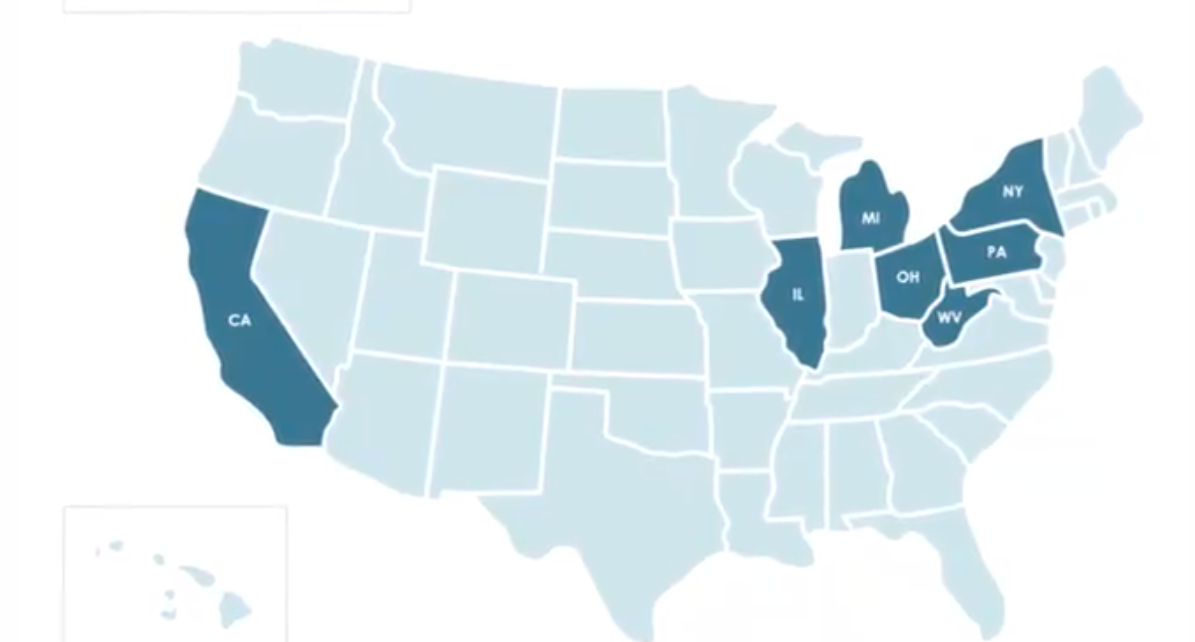
Congressional seat losses following the 2020 Census (Photo: U.S. Census Bureau)
California to Lose 1 Congressional Seat, Electoral Vote According to 2020 U.S. Census
Northeastern, Midwestern states lose seats while Southeastern, non-California Western states see gains
By Evan Symon, April 26, 2021 3:10 pm
Official U.S. Census figures were unveiled on Monday showing that California will lose one congressional seat and electoral vote due to a massive slowdown of population growth.
According to the U.S. Census Bureau, the population of the United States in 2020 stood at 331,449,281, with a growth increase of 7.4%, the second slowest ever. The population shifted largely from the Northeast and Midwest to the Southeast and West between 2010 to 2020. Texas gained 2 seats, with Montana, Colorado, Oregon, Florida, and North Carolina each gaining 1 seat. However, losses of one seat were recorded in Michigan, New York, Pennsylvania, West Virginia, Illinois, Ohio, and California.
Among the population shift trends, California was the outlier, as, despite being a western state, they still lost a seat.
View more than 10 decades of #apportionment and population data by exploring our updated, interactive Historical Apportionment Data Map ???? https://t.co/fBDf8iaYkM #2020Census #CensusBureau pic.twitter.com/HlVUMSXMGa
— U.S. Census Bureau (@uscensusbureau) April 26, 2021
This was largely due to higher costs and higher taxes driving many residents away, although other factors, such as a drop in immigration and emigration, higher death rates, and several businesses leaving the state along with their associated jobs, have also contributed. While California hasn’t gone down in population, the near-stagnant growth rate of .35% is well behind states like Texas with a 1.3% growth rate.
The California GOP said in a statement on Monday that high poverty rates and high gas taxes also played a part in many people leaving the state.
“It is not surprising that California would lose a seat in Congress for the first time in state history because years of failed Democrat policies have taken our state backward,” noted California Republican Party Chairwoman Jessica Millan Patterson in a press release on Monday. “Thanks to America’s worst governor, Gavin Newsom, and his Democrat supermajorities, California is the capital of homelessness and poverty, suffocating gas and income tax rates, and the highest number of residents picking up and moving to more affordable and welcoming states. Californians will have one less voice to speak for us in Washington, which proves yet again that it’s time for change and real leadership. California Republicans have a better vision, and we’re going to build on our 2020 election successes to take back Congress and make the right Californian Speaker of the House of Representatives.”
California remains the largest Congressional bloc despite losses
California losing a house seat also likely means a drop in federal funding for services based on the population in a state, such as Medi-Cal, federal highways, public schools, SNAP, and other services. California’s loss also led to likely gains in several states, off-setting a rise in many traditionally Republican states.
“Californians have been leaving for states such as Idaho, Oregon, Arizona, Colorado, Nevada, Montana, and Texas,” said LA-based Demographics analyst Kyle Sherman to the Globe on Monday. “That exodus definitely helped those states out in gaining residents. And a lot of them don’t like it because they are largely getting Democratic voters as a result. So while a lot of traditionally red states gained seats, the changed population may change who is elected there, and in the long run, help swing those states in the next presidential election.
“Meanwhile, California is sitting there and showing both very conservative and very liberal tendencies, with only the Bay Area showing large population losses within the state. All of this combined spells out very interesting congressional seat re-drawings for 2022.”
While states are currently awaiting more Census data to redraw congressional district, and will likely not start the process until the fall, California will likely broaden out more Northern districts and make more Southern districts smaller due to the population shifts.
However, despite California going from 53 to 52 seats, and Texas moving up from 36 to 38 seats, California still has roughly 10 million more residents than Texas, ensuring their status as the largest state in terms of population for decades to come.
“If you’re looking for a silver lining today, it’s that California is still the largest player in the House and in terms of electoral votes,” added Sherman. “And they have enough time to right the ship back towards growth and avoid the fate of many Rust Belt and Northeastern states in continued loss.
“A big factor may also be natural disasters. California has retrofit against earthquakes and is speeding towards combatting forest fire threats. It may not seem like it, but it’s very much happening. In the Southeast, they can be crippled by a light snowfall and have to face more and more hurricanes and floods in the coming years, and there is very little they can do about both. Who knows what that will do to population shifts in ten years time.”
Additional 2020 Census data is expected to be released throughout the year. The new Congressional changes will first be seen in the redrawn 2022 Congressional elections, with House changes fully taking place by inauguration day 2023.
- San Diego Country Supervisor Jim Desmond Calls San Diego New Epicenter Of Illegal Crossings By Migrants - April 27, 2024
- Oracle Moving Headquarters Out Of Austin Only 4 Years After Moving Out Of California - April 26, 2024
- Congressman Adam Schiff Robbed of his Luggage in San Francisco Car Break In - April 26, 2024





Some should ask the LA Times if they still think California is not losing population to states like Texas and Florida. California lost 1 seat and Texas gained 2. Do the math.
I am very proud to have done my part and contributed to this loss for CA by refusing to participate in the census.
This article still avoids the facts. As a ca resident my entire life people are leaving because of politics. They are tired of high taxes and liberal views not natural disasters.
California’s natural disasters are laughable compared to the states that have ACTUAL disasters. I guess protecting the rich, who have destroyed the landscape with homes cut into the hillsides is something to brag about. Still, people are choosing to leave despite California’s “first world problems” so… It’s not hard to see the real reasons people are leaving. Ridiculous taxes, cost of business operation, ridiculous real estate prices, and politics. California also has the highest homeless population. California has a terrible K-12 rating. With the high taxes and ridiculous real estate, there should be no reason California has some of the highest debt in the nation. Fix our schools, make housing affordable, and make own/operating a business profitable. People will move back!